This week’s article covers .357 SIG headspacing, and if it is controlled at the shoulder or case mouth. I found it was very easy to meet the overall case length spec, and still have a high frequency of misfires as a result of excessive headspace. But first…
Rack ’em up
 I was at the point where three shelves were filled with bullet boxes, a little of this, a little of that, boxes buried behind other boxes, some full and some almost or completely empty. My low inventory warning system consisted of me discovering an empty bullet box at the start of a loading session.
I was at the point where three shelves were filled with bullet boxes, a little of this, a little of that, boxes buried behind other boxes, some full and some almost or completely empty. My low inventory warning system consisted of me discovering an empty bullet box at the start of a loading session.
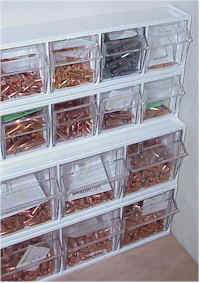 Fortunately I had the insight (a.k.a. my wife told me about them) to locate TiltBins by ArnonCaine. If you have trouble locating them, you might try 800-582-4808 to get a source near you. The clear pivot-to-open bins, are easy to scan for low stock levels. Each has a label slot, so it’s easy to make and change content notation. Relative bin size –
Fortunately I had the insight (a.k.a. my wife told me about them) to locate TiltBins by ArnonCaine. If you have trouble locating them, you might try 800-582-4808 to get a source near you. The clear pivot-to-open bins, are easy to scan for low stock levels. Each has a label slot, so it’s easy to make and change content notation. Relative bin size –
| Size | #Bins | Qty | Bullet |
| Small | 9 | 100 | 243 SBT |
| Medium | 6 | 100 | 338 SBT |
| Medium | 6 | 200 | 45 auto |
| Large | 5 | 400 | 45 auto |
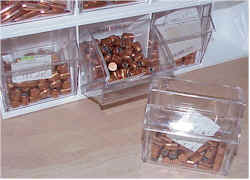 All racks are 24″ wide and, by size, 3″, 4.5″ or 6″ high. The largest projects outward 4″. The racks stack together and have mounting points to secure them to a wall. Free standing, they’re still rock solid. Individual bins are removable, making it easy to rearrange material or move it the reloading press. Price runs from $12 for the large rack to $5 for the smallest of the set.
All racks are 24″ wide and, by size, 3″, 4.5″ or 6″ high. The largest projects outward 4″. The racks stack together and have mounting points to secure them to a wall. Free standing, they’re still rock solid. Individual bins are removable, making it easy to rearrange material or move it the reloading press. Price runs from $12 for the large rack to $5 for the smallest of the set.
After I wrote this, I moved my shell plates, shell holders, primer size conversion kits. and all miscellaneous press parts to the same type storage. The work bench is next.
Handloader’s Manual of Cartridge Conversion
Out of brass for that 11.43 X 49R Romanian Peabody ? Did you know you could make some from .450 2″ Nitro Express brass ? I actually know a guy who would think these were reasonable and routine questions, and I’m sure he is already aware of this book. But for those of you who aren’t….
 “The Handloader’s Manual of Cartridge Conversions”, John J. Donnelly, Stoeger Publishing Company.
“The Handloader’s Manual of Cartridge Conversions”, John J. Donnelly, Stoeger Publishing Company.
The book covers everything from the big .40 and .50 caliber black powder cartridges, to just about anything derived from the .375 H&H, .30/06 and a full range of handgun cartridge conversions – both factory and wildcat.
There are also sections on: turning cases from brass stock on a micro lathe, building up rim thickness on existing brass, heat treating, making case castings, identifying cases, and making bullet. Tremendous source of historical, as well as practical information.. The book was first published in 1987 although, other than some pictures of some obsolete reloading equipment, the cartridge information was all still very valid.
.357 SIG handload reliability…controlling headspace
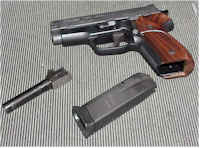 I’ve finally gotten to the point where I have two loads for the SIG P229 that I really like, the gun likes and it seems to show up on the target. Still feel compelled to use both the .40 S & W and .357 SIG barrels, probably just because I bought them both.
I’ve finally gotten to the point where I have two loads for the SIG P229 that I really like, the gun likes and it seems to show up on the target. Still feel compelled to use both the .40 S & W and .357 SIG barrels, probably just because I bought them both.
.357 SIG load
Bullet: Speer 125 grain .357 SIG Gold Dot
Powder: 9.8 grains Alliant Power Pistol
Primer: CCI #500 small pistol
MV: 1450 fps
ME: 580 ft/lbs
.40 S&W load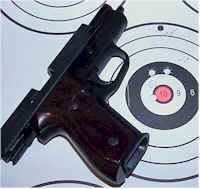
Bullet: Hornady 155 HP/XTP
Powder: 7.5 grains Unique
Primer: CCI #500 small pistol
MV: 1150 fps
ME: 455 ft/lbs
The group to the right of the trigger guard is a 1.5″ group from the .357 SIG round. The .40 runs about .5″ larger. The hole at the extreme top of the target is what always happens to the first shot immediately after changing over barrels.
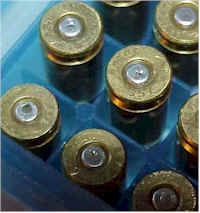 I ran through maybe 25 rounds of .40 S&W, switched over to the .357, fired 5 rounds, and then started having misfires. In the picture, you may be able to see a very shallow firing pin indentation, and notice the rounds toward the top are unfired.
I ran through maybe 25 rounds of .40 S&W, switched over to the .357, fired 5 rounds, and then started having misfires. In the picture, you may be able to see a very shallow firing pin indentation, and notice the rounds toward the top are unfired.
I thought I had broken a firing pin. I ran some Remington factory loads through the gun, and they all functioned normally. The firing pin indentations were a little shallow, compared to the .40’s I had just fired, so I assumed I had a headspace problem.
 In the picture to the right you can see the variations in firing pin contact. That’s a .40 S&W on the left, fired and unfired .357 in the center, and a factory fired .357 on the right.
In the picture to the right you can see the variations in firing pin contact. That’s a .40 S&W on the left, fired and unfired .357 in the center, and a factory fired .357 on the right.
In publications, the .357 SIG has been referenced as head spacing on the case mouth, head spacing on the shoulder and on both the mouth and shoulder. The suggestion of shoulder spacing, or both, appeared in magazine articles, with source credit going to “unidentified factory personnel” (i.e. “A factory tech told me…”).
I don’t think a reloaded case could realistically hold a consistent tolerance, where both mouth and shoulder could easily be reconciled. Sierra indicates head spacing on the case mouth, establishing a maximum case length of .865″, and a trim length of .860″. Certainly a traditional dimensional range and approach for an autoloader, however, this may not be correct.
 The chamber length from surface #1 to the farthest edge of the .357 chamber is .875″, or .010″ greater than the maximum case length spec. Since the case mouth would never contact the edge of the chamber, headspace could not be determined at this location.
The chamber length from surface #1 to the farthest edge of the .357 chamber is .875″, or .010″ greater than the maximum case length spec. Since the case mouth would never contact the edge of the chamber, headspace could not be determined at this location.
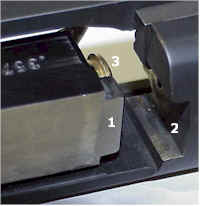 With incorrect case length ruled out, something else had to be creating the variations I was seeing in headspace. At lock up, the barrel (1) should be back against the slide (2) and the case rim (3) should be secured between the two.
With incorrect case length ruled out, something else had to be creating the variations I was seeing in headspace. At lock up, the barrel (1) should be back against the slide (2) and the case rim (3) should be secured between the two.
If at lock up, the space between 1 & 2 is zero, then the headspace variance had to be created by the difference between the two parallel surfaces 1 and 3. In the absence of factory chamber specs, I felt I could use relative measurements and comparisons.
I set up the dial indicator to read the face of the upper barrel lug as zero and the step up or down to the  case head as the variance dimension. A positive case head measurement should represent contact with the recoil face of the slide, and a negative reading, the degree of headspace.
case head as the variance dimension. A positive case head measurement should represent contact with the recoil face of the slide, and a negative reading, the degree of headspace.
I also measured overall case length to verify there was no correlation, in this specific case, between case length and headspace.
| Brass | Rim to barrel face |
Case Length |
Results |
| Speer | -.004″ | .858 | Did not fire |
| Speer | -.005 | .860 | Did not fire |
| Speer | .012 | .855 | Fired |
| Speer | .009 | .857 | Fired |
| Speer | .010 | .853 | Fired |
| Speer | .009 | .851 | Fired |
| Speer | .012 | .857 | Fired |
| Remington | .005 | .864 | Fired |
| Remington | .008 | .860 | Fired |
| Remington | .005 | .864 | Fired |
| Remington | .009 | .862 | Fired |
| Remington | .010 | .862 | Fired |
Case length, in this specific application, was of no impact on headspace or firing reliability. Cases as short as .851″ fired without a problem, and none came within .011″ of the case mouth contacting the forward end of the chamber.
To validate the barrel/rim variance as the significant factor, I measured two full boxes of reloads in the same manner. By pointing to the cartridges with a variance of -.004″ or greater, I could consistently predict which cartridges would not fire, a test which held up without exception.
Conclusion
 The .357 SIG headspace is determined by the shoulder not the case mouth, just like the .400 Cor-Bon and virtually every other rimless or rebated rim bottle neck cartridge. Probably why people have frequently and successfully used necked down .40 S&W brass to make .357 SIG cases, even though the .40 S&W is over .020″ shorter.
The .357 SIG headspace is determined by the shoulder not the case mouth, just like the .400 Cor-Bon and virtually every other rimless or rebated rim bottle neck cartridge. Probably why people have frequently and successfully used necked down .40 S&W brass to make .357 SIG cases, even though the .40 S&W is over .020″ shorter.
The RCBS die set I have, when adjusted to the standard factory procedure, yields cases with an improperly positioned shoulder, the shoulder has excessive setback.
I learned how to use my barrel and a dial indicator as a headspace gauge, to be used to fine tune my sizing die adjustments, and I have a simple way to insure I will get reliable ignition, before I incorrectly load hundreds of rounds of ammo.
The problem was me. I focused on case length as the primary element in controlling headspace, rather than shoulder placement. So now it’s shoulder dimensions first, and make sure case length doesn’t stretch beyond spec and interfere with proper headspacing.
The .357 SIG is a great cartridge. I think it just needs to be loaded like a small rifle cartridge, rather than a straight walled pistol cartridge. I’ll feel better when there is more mature published data on loading the cartridge.
Thanks,
Joe

Email Notification